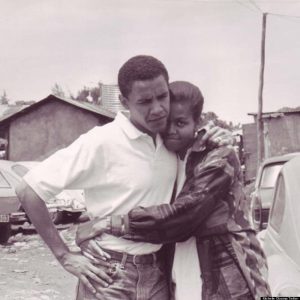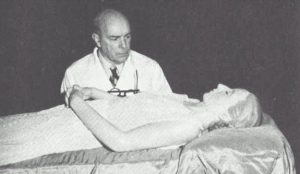As reporters and health officials walked onto the grounds of the mass suicide in Guayana, they were in shock over what they were seeing; hundreds of bodies face down on the ground, dead. One person who was at the site said that the amount of dead bodies was appalling, “it was depicted as not American, not religious, not sane, and ultimately not human.”1 Over 550 bodies of the 900 were unclaimed for almost six months until US Officials decided to cremate them. Once they brought the bodies back to the United States from Guayana, many Americans didn’t think it was right to have these bodies spread out on American soil because of the act they made. US Officials then decided to scatter the ashes of the dead bodies away from the United States border lines.

It all started with Jim Jones. Jones was a religious/political cult leader who had established the People’s Temple as a sect in Indianapolis in the 1950s. His cult focused on themes of communism, and the fight against racism, attracting many African Americans. He moved his cult to San Francisco in 1971, but it would not remain there for long. Soon after the group moved there, Jones was accused of financial fraud, physical abuse of his cult’s members, and mistreatment of children. After Jones was accused, in 1973, he became paranoid that someone would try to destroy his cult, so he moved his entire group to Guayana, South America, to build a socialist utopia known as Jonestown.

Once the cult moved to Guayana, people started to question even more the accusations being made against Jim Jones. Members who had left or escaped the cult were worried for the people still in the cult, so they convinced U.S. Congressmen Leo Ryan of California to fly to Guyana. “In November 1978, Ryan along with a group of journalists and relatives of cult members went to investigate the charges.”2 Jones did not like the idea of people coming to investigate, so he ordered his followers to have Ryan and his investigators assassinated. He ordered the attack on the group as they were returning to the airstrip to leave. A journalist named Charles Krause reported that that morning Ryan was attacked by a man with a knife, although he was not hurt by the incident. “Later that same day, Ryan and his party were attacked by assassins at the Port Kaituma Airstrip. Ryan and four others were killed and ten were injured.”3 While these killings were going on, Jones feared that he would lose his cult members and they would turn against him. He then proceeded to lead his people through a mass suicide, which was something the members had repeatedly practiced since the early 1970s.
These practices were called “White Nights” and consisted of members drinking a liquid that they believed was poisonous as a loyalty test to Jones.4 During these “White Nights,” people were woken up by a loud speaker, and they would assemble for the ritual of passing around a drink of kool-aid, which they were told was poison. Unfortunately, this time was not a test. Hundreds of adults and children lined up to drink this colorful, fruit-flavored punch, which contained cyanide and tranquilizers. Most of them thought they were just proving their loyalty as before, but as more people began to die, they realized that this time it was real. “Over 260 children, for example, had the poison given to them, while only about 40 adults escaped.”5 For those who died willingly though, collective suicide held a religious significance in the context of the worldview that had been established in Jonestown.

Collective suicide was a ritual that signified a purity of commitment to the community. On the night that they all drank this poison, Jim Jones announced “that the members of the community were united as black, proud socialists.”6 Collective suicide also promised release from a world dominated by what Jones perceived as American racism, capitalism, and fascism. He did not want to be captured and taken back to America, so instead he urged his followers to drink the poison, and “step out of the world.”7 Jones had told his followers that they were not committing suicide, but rather they were performing an act of freeing themselves from the harsh world that they lived in. There are later reports that when officials went to Jonestown, Jim Jones was found with gunshot wounds, raising the speculation that either he had committed suicide or someone else had killed him.
The Jonestown Massacre was the largest mass suicide in modern history and resulted in the largest single loss of American civilian life in a non-natural disaster until the September 11 attack in 2001. The mass suicide resulted in over 900 deaths of innocent lives. Once the bodies were found, the Guyanese government asked the United States to take the bodies back. US Officials decided to start sending a few people over to identify bodies so they could decide what to do with them. Over 500 bodies were unclaimed and that is when the United States decided to have the US Air Force come in to take the bodies back to the United States.”8 To this day, families of loved ones are still trying to find a memorial place for the lost lives.
- Encyclopedia of Religion, 2005, s.v. “Jonestown and Peoples Temple,” by David Chidester. ↵
- Dictionary of American History, 2003, s.v. “Jonestown Massacre,” by Carolyn Bronstein. ↵
- Dictionary of American History, 2003, s.v. “Jonestown Massacre,” by Carolyn Bronstein. ↵
- Dictionary of American History, 2003, s.v. “Jonestown Massacre,” by Carolyn Bronstein. ↵
- Encyclopdeia of Religion, 2005, s.v. “Jonestown and Peoples Temple,” by David Chidester. ↵
- Encyclopdeia of Religion, 2005, s.v. “Jonestown and Peoples Temple,” by David Chidester. ↵
- Encyclopdeia of Religion, 2005, s.v. “Jonestown and Peoples Temple,” by David Chidester. ↵
- Encyclopdeia of Religion, 2005, s.v. “Jonestown and Peoples Temple,” by David Chidester. ↵



150 comments
Vanessa Tombo
This article was extremely educational and chilling at the same time. There are many different compartments in the human brain that allow each person to make sound decisions. This article has demonstrated that humans are able to be taken advantage of, especially children. They are the most trusting and vulnerable in our societies. In this article, 260 children drank the kool-aid as a means of demonstrating their loyalty to the community. Children born into these societies do not know that there are other ways of living beside their communities they have been raised. In seeing that minds can be easily corrupted we must readjust our notion of what freedom means.
Michael Thomas
I found this article interesting because of how it details the history of Jim Jones and his cult. I remember watching a documentary about Jim Jones and Jonestown. Paranoia had control over Jones, believing that his influence would be taken away. If Jim Jones was detained before building Jonestown, nobodies life would have been taken because of Jim Jones paranoia.
Julio Morales
I first learned about this mass suicide in the 10th grade in my psychology class, but I never knew all the details that followed this story. I just don’t understand how he had a following of 900 people and they all committed suicide because he told them it would free them from this harsh world. Its sad to learn that many bodies were not claimed.
Timothy ODekirk
I have heard of this story for years, but I have honestly forgotten about this tragic event, and the article had brought up the worst of human nature. I am a huge fan of cults because I just find them fascinating and honestly creep overall/. This cult is no exception and extremely creepy and disturbing to me. But, what disturbes me the most about this whole instant is not only the fact that there were 900 lives lost on that day, but the fact that they were convinced to commit suicide and they openly chose to do so. That is the most disturbing part to me. The Jones town Massacre was one of the greatest massacre during our time and we will forever be scared from it, at least I will.
Saira Castellanos
A lot of these articles have amazed me in so many ways. Why in the world have we not learned about any of this? I had heard about the kool-aid filled with poison in a Family Guy episode, but I didn’t know it actually happened. I thought maybe it was just something out a movie I had never seen. This is crazy to me. This man was basically like Hitler telling people that Jews were the root of all their problems so they let him try to wipe out innocent people off the face of the Earth. I feel bad for whoever was the first to see all these bodies in the field.
Maria Esquivel
Instead of helping them, he was manipulating them with lies and testing their loyalty. This was my first time hearing about Jonestown and wow, it is horrible. It’s sad to read about how many children lost their lives because of Jones and how scared this man was of someone finding him that he decided to influence his group into taking their own lives to finally be free.
Alexandra Lopez
Although I enjoyed the information in this article, it was a devastating read. All of these innocent people brainwashed into believing that a single man can give them power and freedom by drinking a poisonous fluid to vouch their loyalty to him is just sad. Children and parents in the cult collapsing to the ground, taking their final breaths together. It’s unfortunate to know one man was able to construct this act. Although his followers believed he was their savior, he was a manipulative monster.
Derek Esquivel
This article is just a sad read overall. Knowing that these people were basically being brainwashed and were trusting every single word that Jones was telling them just to be given a poisonous drink that would kill almost 1000 people. It is just terrible to see how badly treated these people were because of how it seems that they were needing to trust someone in their lives but they were never actually gaining any trust for him.
Alexandra Cantu
What a devastating story. I had never heard of the Jonestown Massacre. It is so sad to hear that so many innocent lives were taken especially those children. Jim Jones was such a coward, he was a man who could not stand on his on. He manipulated many and ran away from the American government who were only trying to protect those individuals. What started of right to fight against racism went completely wrong.
Fumei P.
What happened in Jonestown was a tragedy. Jim Jones was a lunatic who brainwashed his followers into believing that collective suicide was a ritual that signified a purity of commitment to the community. Only an evil person could manipulate the mass suicide of 900 to include 260 children. It is heartbreaking when people who are looking for meaning or belonging become trapped in these types of cults, ran by religious despots.